|
|
| |
TERMINATING COAXIAL CONNECTORS |
 |
Cable Types
There are three basic communications cables used. They are coaxial cable for video applications. Cat5e UTP cable for data networking and Cat 3 used in telephone applications
Coax Cable
RG-59 Generally not recommended anymore for CATV or Satellite. Smaller 22 AWG center conductor with 40% braiding, thinner in diameter than RG-6. Loses 80-90% of a signal every 100ft.
RG-6 is recommended by CATV and Satellite. 18 AWG center conductor with 60% braiding. Loses about 50% of the signal every 100ft.
RG-6 Quad is double shielded with two layers of foil and braiding with a 18 AWG center conductor. Use when extra protection from outside interference in needed. Loses about 50% of the signal every 100ft. |
|
| Coax Connector Types |
Typical coaxial cable connectors used for CATV, satellite and video applications are called "F" connectors. Available in a compression, one-piece crimp, push-on, and a twist-on style. For security applications, BNC style connectors are used. They are available in crimp or compression style.
Twist on are the easiest to use but can be pulled off the end of the cable. Crimp On have been the standard connector used for many years. Push On are a great alternative and really stay on the end of the cable and require no extra tools to install. Compression connectors add a watertight seal and are recommended by satellite and CATV providers.
The connectors are available for RG-59, RG-6 and RG-6 Quad coaxial cables. Make sure to match the connector to the type of coaxial cable you're installing.
|
| Compression |
Push-On |
Crimp-On |
Twist-On |
 |
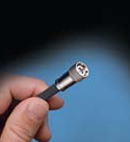 |
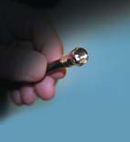 |
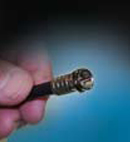 |
| Pro Connection |
Best Connection |
Better Connection |
Good Connection |
|
| COAXIAL/CONNECTOR SELECTION GUIDE |
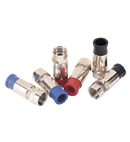 |
|
Pro-Compression Connector
Professionals use compression connectors because they are approved by cable and satellite providers. However, they are easy enough for anyone to install. The connector is permanent and does not putt off the cable and provides a watertight connection.
|
|
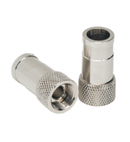 |
|
Best-Push On Connector
After stripping the cable and folding back the braiding, the connector is "pushed" onto the cable until the white dielectric is even or flush with the small opening. The push-on connector is a permanent termination and cannot be pulled off.
|
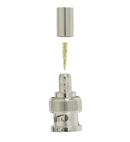 |
|
Better-Crimp on Connector
Crimp On connectors use a crimping tool to install the connector onto the end of the cable. After stripping the cable, the connector is pushed onto the cable. Simply load the connector into the correct hole in the tool and squeeze the tool until it releases (more detailed instructions included with tool). |
|
 |
|
Good-Twist On Connector
Twist on connectors simply thread onto the outer jacket of the cable after it has been stripped. They require no additional tools to install. Just twist the connector onto the cable until it is fully sealed.
|
|
| DEFINITION OF TERMS |
Braid
Same as shielding- Typically made from a number of smaller aluminum or copper conductors interwoven together to form an outer conductor around the dielectric core. The braiding stops lower frequency noise from interfering with the signal traveling down the center conductor.
Center Conductor
RG-6 and RG-6 Quad have a 18 AWG copper coated steel conductor that carries the signal.
Dielectric
Insulation used to separate between the center conductor and braid shielding conductor of coax cable.
Foil
The foil shield stops higher frequency noise (RFI) from interfering with the signal traveling down the center conductor.
Jacket
Outer material serves as a protective covering from the environment and may also add in the overall flame retardant properties of the cable. |
TERMINATING A DATA JACK |
Step 4
|
Compression F-Style
Place the connector onto the end of the cable until the white dielectric is flush with the center hole of the connector. Insert the connector into the tool and squeeze the handle until the connector is fully compressed.
Crimp F-Style
Insert stripped cable into connector until the white dielectric is even with the center hole. Crimp per tool's instructions.
Compression BNC
Insert stripped cable into BNC connector until the white dielectric reaches a point where you can feel the center conductor connect with the inner center pin socket.
Compress per your tool's guidelines.
(Note: To help approximate how much cable to push into the connector for the center conductor to grab, you can do the following: Hold stripped cable against the connector as shown in photo to the right. End of center conductor should line up with movable portion of the connector. Mark cable where it meets end of conductor. The mark show how to insert to fully seat conductor.) |
|
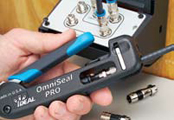 |
 |
| Cat. No. 30-603 |
Finish connector |
| |
|
 |
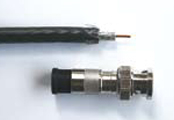 |
|
|
|
|
|